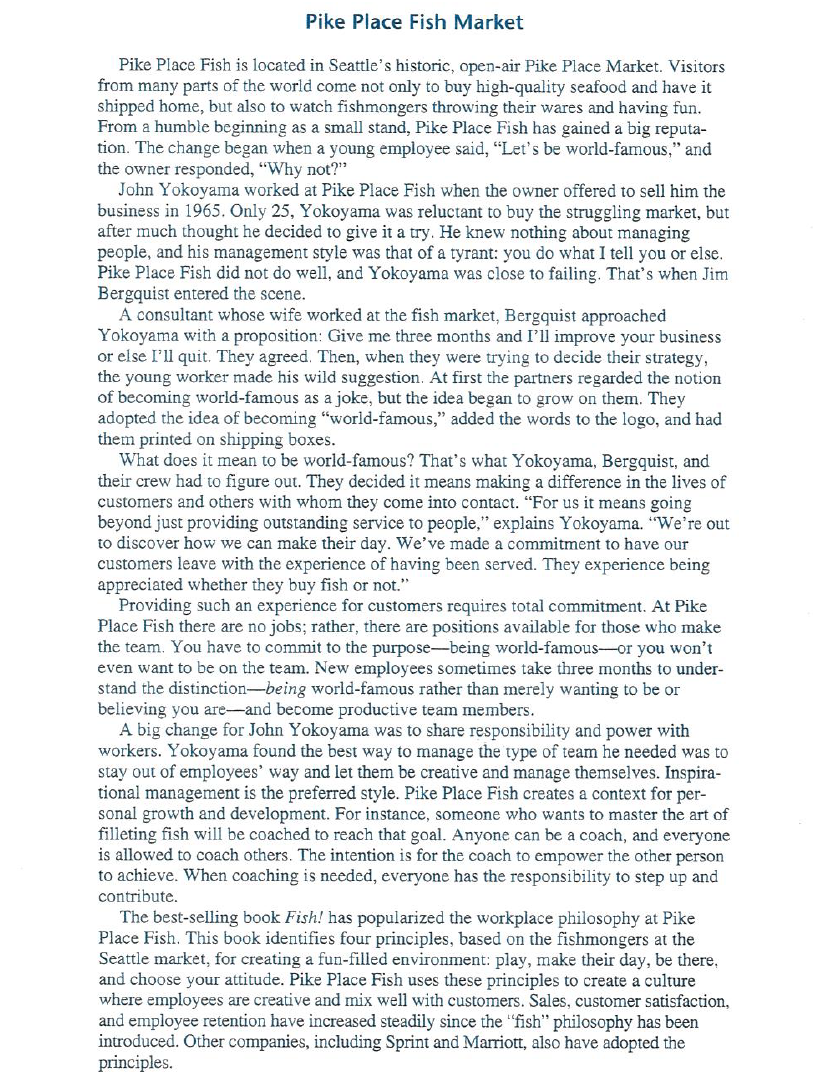Question
a. How would you describe the leadership style of John Yokoyama before and after the changes implemented by Jim Bergquist? Explain. Be specific as to
a. How would you describe the leadership style of John Yokoyama before and after the changes implemented by Jim Bergquist? Explain. Be specific as to why you have chosen this style and what qualities and/or behaviours do you observe in John, which made/make him this type of leader, in your opinion?
b. Describe the changes that happened in the work environment at Pike's Place. What do you like/dislike about these changes? Would you have done things differently, if you were hired as a consultant instead of Jim? Explain your answer. Your answers should be based on a critical analysis of the situation as well as the qualities and behaviours Jim exhibits and what he had taught the owner (Mr. Yokoyama) in the process. You should also provide a well-justified personal opinion, based on your assessment of the transformation, which happened at Pike's Place.

Pike Place Fish Market Pike Place Fish is located in Seattle's historic, open-air Pike Place Market. Visitors from many parts of the world come not only to buy high-quality seafood and have it shipped home, but also to watch fishmongers throwing their wares and having fun. From a humble beginning as a small stand, Pike Place Fish has gained a big reputa- tion. The change began when a young employee said, "Let's be world-famous," and the owner responded, "Why not?" John Yokoyama worked at Pike Place Fish when the owner offered to sell him the business in 1965. Only 25, Yokoyama was reluctant to buy the struggling market, but after much thought he decided to give it a try. He knew nothing about managing people, and his management style was that of a tyrant: you do what I tell you or else. Pike Place Fish did not do well, and Yokoyama was close to failing. That's when Jim Bergquist entered the scene. A consultant whose wife worked at the fish market, Bergquist approached Yokoyama with a proposition: Give me three months and I'll improve your business or else I'll quit. They agreed. Then, when they were trying to decide their strategy, the young worker made his wild suggestion. At first the partners regarded the notion of becoming world-famous as a joke, but the idea began to grow on them. They adopted the idea of becoming "world-famous," added the words to the logo, and had them printed on shipping boxes. What does it mean to be world-famous? That's what Yokoyama, Bergquist, and their crew had to figure out. They decided it means making a difference in the lives of customers and others with whom they come into contact. "For us it means going beyond just providing outstanding service to people," explains Yokoyama. "We're out to discover how we can make their day. We've made a commitment to have our customers leave with the experience of having been served. They experience being appreciated whether they buy fish or not." Providing such an experience for customers requires total commitment. At Pike Place Fish there are no jobs; rather, there are positions available for those who make the team. You have to commit to the purpose-being world-famous-or you won't even want to be on the team. New employees sometimes take three months to under- stand the distinction-being world-famous rather than merely wanting to be or believing you are-and become productive team members. A big change for John Yokoyama was to share responsibility and power with workers. Yokoyama found the best way to manage the type of team he needed was to stay out of employees' way and let them be creative and manage themselves. Inspira- tional management is the preferred style. Pike Place Fish creates a context for per- sonal growth and development. For instance, someone who wants to master the art of filleting fish will be coached to reach that goal. Anyone can be a coach, and everyone is allowed to coach others. The intention is for the coach to empower the other person to achieve. When coaching is needed, everyone has the responsibility to step up and contribute. The best-selling book Fish! has popularized the workplace philosophy at Pike Place Fish. This book identifies four principles, based on the fishmongers at the Seattle market, for creating a fun-filled environment: play, make their day, be there, and choose your attitude. Pike Place Fish uses these principles to create a culture where employees are creative and mix well with customers. Sales, customer satisfaction, and employee retention have increased steadily since the "fish" philosophy has been introduced. Other companies, including Sprint and Marriott, also have adopted the principles.
Step by Step Solution
3.40 Rating (153 Votes )
There are 3 Steps involved in it
Step: 1
1 John Yokoyama was only 25 when he bought Pike Place Fish back then he was tyrant leader Everyone w...
Get Instant Access to Expert-Tailored Solutions
See step-by-step solutions with expert insights and AI powered tools for academic success
Step: 2

Step: 3

Ace Your Homework with AI
Get the answers you need in no time with our AI-driven, step-by-step assistance
Get Started


